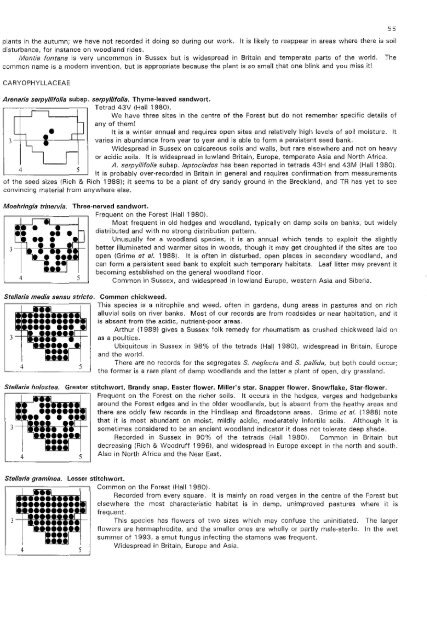Flora of Ashdown Forest - Botanical Society of the British Isles
Flora of Ashdown Forest - Botanical Society of the British Isles
Flora of Ashdown Forest - Botanical Society of the British Isles
You also want an ePaper? Increase the reach of your titles
YUMPU automatically turns print PDFs into web optimized ePapers that Google loves.
plants in <strong>the</strong> autumn; we have not recorded it doing so during our work. It is likely to reappear in areas where <strong>the</strong>re is soildisturbance, for instance on woodland rides.Montia fontana is very uncommon in Sussex but is widespread in Britain and temperate parts <strong>of</strong> <strong>the</strong> world, Thecommon name is a modern invention, but is appropriate because <strong>the</strong> plant is so small that one blink and you miss it!CARYOPHYLLACEAEArenaria serpyllifo/ia subsp. serpyllifolia. Thyme~leaved sandwort.Tetrad 43V (Hall 19801.We have three sites in <strong>the</strong> centre <strong>of</strong> <strong>the</strong> <strong>Forest</strong> but do not remember specific details <strong>of</strong>any <strong>of</strong> <strong>the</strong>m!It is a winter annual and requires open sites and relatively high levels <strong>of</strong> soil moisture. It] -++--I----'_+_ varies in abundance from year to year and is able to form a persistent seed bank.4 5Widespread in Sussex on calcareous soils and walls, but rare elsewhere and not on heavyor acidic soils. It is widespread in lowland Britain, Europe, temperate Asia and North Africa.A. serpyliifolia subsp. leptoelados has been reported in tetrads 43H and 43M (Hall 1980).It is probably over-recorded in Britain in general and requires confirmation from measurements<strong>of</strong> <strong>the</strong> seed sizes (Rich & Rich 1988); it seems to be a plant <strong>of</strong> dry sandy ground in <strong>the</strong> Breckland, and TR has yet to seeconvincing material from anywhere else.Moehringia trinervia. Three-nerved sandwort.Frequent on <strong>the</strong> <strong>Forest</strong> (Hall 1980).Most frequent in old hedges and woodland, typically on damp soils on banks, but widelydistributed and with no strong distribution pattern.Unusually for a woodland species, it is an annual which tends to exploit <strong>the</strong> slightlybetter illuminated and warmer sites in woods, though it may get droughted if <strong>the</strong> sites are tooopen (Grime et al. 1988). It is <strong>of</strong>ten in disturbed, open places in secondary woodland, andcan form a persistent seed bank to exploit such temporary habitats. Leaf litter may prevent itbecoming established on <strong>the</strong> general woodland floor.Common in Sussex, and widespread in lowland Europe, western Asia and Siberia.Stellaria media sensu stricto. Common chickweed.This species is a nitrophile and weed, <strong>of</strong>ten in gardens, dung areas in pastures and on richalluvial soils on river banks. Most <strong>of</strong> our records are from roadsides or near habitation, and itis absent from <strong>the</strong> acidic, nutrient-poor areas.Arthur (1989) gives a Sussex folk remedy for rheumatism as crushed chickweed laid onas a poultice.Ubiquitous in Sussex in 98% <strong>of</strong> <strong>the</strong> tetrads (Hall 1980), widespread in Britain, Europeand <strong>the</strong> world.There are no records for <strong>the</strong> segregates S. neglecta and S. pa//ida, but both could occur;<strong>the</strong> former is a rare plant <strong>of</strong> damp woodlands and <strong>the</strong> latter a plant <strong>of</strong> open, dry grassland.Stellaria holostea. Greater stitchwort, Brandy snap, Easter flower, Miller's star, Snapper flower, Snowflake, Star-flower.,-,-:==:---,--, Frequent on <strong>the</strong> <strong>Forest</strong> on <strong>the</strong> richer soils. It occurs in <strong>the</strong> hedges, verges and hedge banksaround <strong>the</strong> <strong>Forest</strong> edges and in <strong>the</strong> older woodlands, but is absent from <strong>the</strong> heathy areas and<strong>the</strong>re are oddly few records in <strong>the</strong> Hindleap and Broadstone areas. Grime et al. (1988) notethat it is most abundant on moist, mildly acidic, moderately infertile soUs. Although it is3sometimes considered to be an ancient woodland indicator it does not tolerate deep shade.Recorded in Sussex in 90% <strong>of</strong> <strong>the</strong> tetrads (Hall 1980). Common in Britain butdecreasing (Rich & Woodruff 1996), and widespread in Europe except in <strong>the</strong> north and south.45Also in North Africa and <strong>the</strong> Near East.55Stellaria graminea.Lesser stitchwort.Common on <strong>the</strong> <strong>Forest</strong> (Hall 1980).Recorded from every square. It is mainly on road verges in <strong>the</strong> centre <strong>of</strong> <strong>the</strong> <strong>Forest</strong> butelsewhere <strong>the</strong> most characteristic habitat is in damp, unimproved pastures where it isfrequent.This species has flowers <strong>of</strong> two sizes which may confuse <strong>the</strong> uninitiated.flowers are hermaphrodite, and <strong>the</strong> smaller ones are wholly or partly male-sterile.summer <strong>of</strong> 1993, a smut fungus infecting <strong>the</strong> stamens was frequent.Widespread in Britain, Europe and Asia.The largerIn <strong>the</strong> wet
















